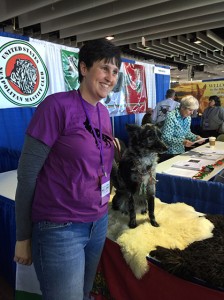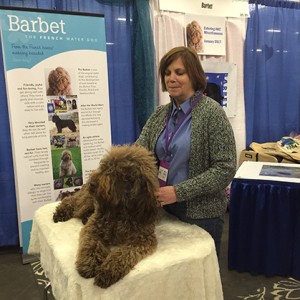And Now for Something Different: The Mudi and the Barbet
By Joan Harrigan
“Spring” curled pensively on a chair at Pier 92, surveying the curious onlookers. The 7-year-old Mudi is more accustomed to activity—flyball is her game, and she loves to run. Formally known as Kiralytanyai Tavasz (“Tavasz” means “spring” in Hungarian), Spring and her owner, Amanda Haldeman of Hampden, Mass. have come to “Meet & Compete” at the Piers to “get the word out” about this primitive breed.
Mudis are herding dogs, known for their intelligence and drive. They are an AKC FSS breed, and Haldeman explains that like the Pumi, the Mudi was derived from the Puli. At 20 pounds and 16½ inches, Spring is a typical size for a bitch. Her silver and black markings, known in the breed as black merle, are arresting. With her prick ears and intense gaze, she seems to understand exactly what you are saying. “They are alert barkers, and probably not suited for apartments,” Haldeman says. A Mudi needs a job, as well as regular exercise. And while Mudis don’t solicit attention from strangers, they should accept it, so early socialization is essential.
Haldeman says that Mudis make great performance dogs and are perfect running companions. While Spring patiently posed for her photograph, she left little doubt that her preference would be the “Compete” side of this “Meet and Compete” event!
Over at Pier 94, Barbet owners Stacy Able of Indianapolis, Ind. and Judy Descutner of Hickory, Pa. are accompanied by Barbets Indy and Marlee. Able’s Indy is only 10 months old, but he’s handling the crowds with aplomb. Barbets will join the AKC’s Miscellaneous Group in January 2017. They originated in France and were described as early as the 14th century. Their name means “bearded” in French, and they are related to the Poodle, as well as the Briard, Bishon Frise, and other similar breeds.
Able was introduced to the breed by her sister-in-law, who imported one from Denmark 15 years ago. She characterizes the breed as happy, smart, clownish, and loyal—all of hers follow her from room to room as she moves about her home. Descutner, who breeds Barbets under the Hickory Tavern prefix, points out that they are not dogs to be left at home alone all day—if you do, “they can be naughty,” she laughs.
Barbets are engaging, medium-sized dogs, with tousled curls that must be line-brushed regularly to prevent matting. Unlike their cousin the Poodle, after bathing, Barbets are allowed to air dry to preserve their natural curls. They are also shown naturally—indeed their breed standard calls for any sculpturing to be severely penalized.
The charm of the breed is undeniable. Indy and Marlee are shaggy, happy dogs who can’t help but make you smile. Descutner’s website sums them up succinctly: “the Barbet has all of the attributes that people seek in the Labradoodle, but in a pedigreed, registered, health-tested, time-honored package.” This is a breed that seems destined to become popular as a family dog and all-round companion.
Short URL: https://caninechronicle.com/?p=98215
Comments are closed













